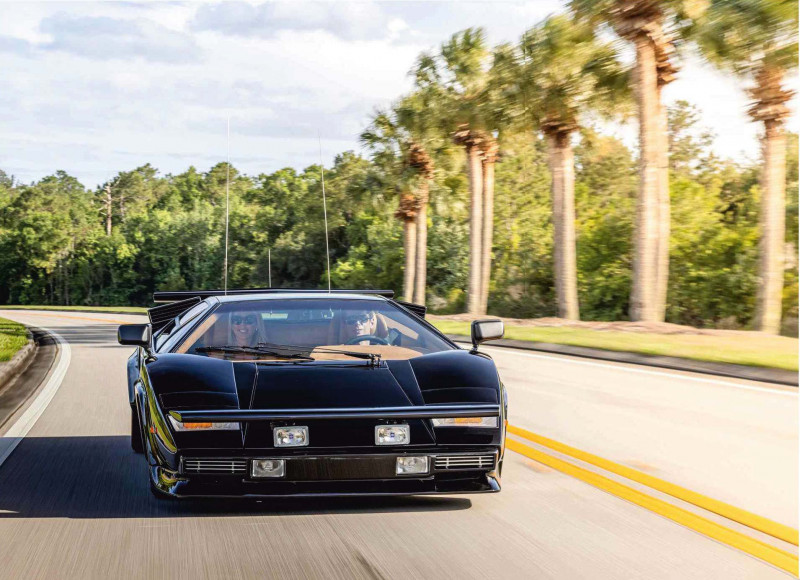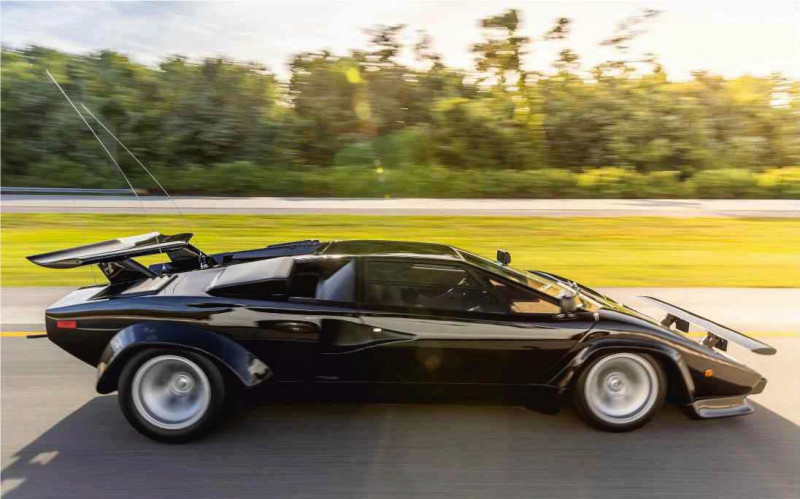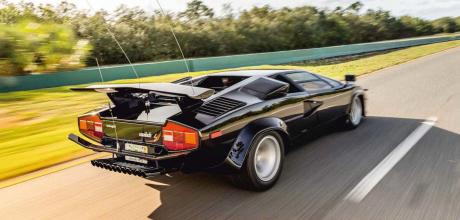1979 Lamborghini Countach LP 400 S
As the Lamborghini Countach celebrates its 50th anniversary, Octane tracks down the star of one of the greatest petrolhead movies of all time: The Cannonball Run. Words Massimo Delbo. Photography courtesy of Preston Rose/Hagerty Drivers Foundation.
Celebrating the Cannonball Run star
Forget the serious stuff. If you search online for the best ten movies ever, you can be sure it won’t show up. It’s not even top 100. But, if you are reading this, it’s most likely that you love cars. And you’ll know that when The Cannonball Run appeared in June 1981 it set a new standard for a Hollywood movie about cars, the plot is funny, sometimes almost surreal, and the cast is stellar: Burt Reynolds, Roger Moore, Farrah Fawcett, Jackie Chan, Dean Martin… But what really makes the difference between this and every other car movie is the number of cars involved, and the desirability of those cars.

'HOLLYWOOD FICTION TOOK OVER AND MADE A STAR OF THE COUNTACH, WHICH WON THE RACE IN THE FILM'
As in The Italian Job, the opening scene is iconic — and it depicts a Lamborghini. But being 12 years younger, instead of the rounded shape of an orange Miura P400, The Cannonball Run focuses on a sharp, double-winged, black Countach LP 400 S. the 3min 26sec of the opening scene, with the 12-cylinder downdraught carburettor soundtrack accompanying it, is so ingrained in automotive legend that many Countach owners (both of the period and even today!) have admitted that they got the Lamborghini bug from watching it.

Above Flared ’arches were pioneered by Walter Wolf’s factory one-off and standardised for the 400 S; aerials, front wing and bank of 12 exhausts were modifications made for the movie.
In the movie, a stretch of tarmac just south-east of Las Vegas, linking the city of Henderson with Boulder City, was the scene of a 1979 Countach playing tag with a 1980 Pontiac Trans-Am 4.9 Turbo T-Top — one of the Nevada Highway Patrol’s finest, that Countach is the one you see here. And the film is based on the story of an actual and heroic road run, inspired by the pioneering trans-American journeys of Erwin George ‘Cannon Ball’ Baker, which was held as a protest against draconian new traffic laws.

In the autumn of 1973, in response to the OPEC oil embargo linked with the Suez Canal crisis and the Yom Kippur War, the USA’s then-President Richard Nixon issued an executive order: the Emergency Highway Energy Conservation Act. this document, approved by Congress in January 1974, slowed down the whole country, imposing a national speed limit of just 55mph (88.5km/h). It was supposed to last 12 months but the expiry was removed a year later. It became the nightmare of every American motorist for two decades, as well as bringing in millions of dollars in fines.
the despair spread to Europe, where sports car manufacturers saw the export potential of the profitable American market shrink overnight. In Sant’Agata Bolognese, the timing couldn’t have been worse. In March 1971, 50 years ago, Lamborghini had presented its new concept car, the Countach LP 500, on the Bertone stand at the Geneva motor show. Following a couple of years of development, it was ready for manufacture in tiny numbers from January 1974, launched as the Countach LP 400, with a correspondingly smaller engine. And it was inspired by the need to replace the still successful Miura with something that could be homologated for sale in the USA. Doing that with a car capable of more than America’s new legal limit in first gear was not the perfect marketing dream.
But when you talk about dreams, you find visionaries ready to fight passionately for their idea. Some members of the American car community protested vehemently, demonstrating that the safety reasons behind the new speed limits were unproven. And time would prove they were right. In 1970, over a beer or two with Car & Driver colleagues, Brock Yates — famed motoring journalist, writer and CBS pit reporter and commentator for the Winston Cup (today NASCAR) — had suggested an informal cross-country race, they even chose its name — the Cannonball Baker Sea-to- Shining-Sea Memorial Trophy Dash — to celebrate the spirit of the late Erwin George ‘Cannon Ball’ Baker, famous for his record-breaking cross-country journeys.

Baker’s reputation dated back to the early 1900s, when he was paid to promote motorcycles and cars by making record- setting cross-country drives — 143 of them. He usually set a new speed record each time as, without one in place, the sponsor wouldn’t pay. Among the records, his 1915 drive from Los Angeles to New York City in a Stutz Bearcat (11 days, 7 hours and 15 minutes) was beaten by almost four days the following year, in a Cadillac 8 Roadster. In 1933, indicative of the progress of his mounts, his 53.5-hour New York to LA record was set in a Graham-Paige Model 57 Blue Streak 8. this is the adventure that inspired Yates when he was thinking about what would become ‘the Cannonball’.
In spring 1971 Yates was ready to follow in Baker’s tyretracks. Together with Steve Smith, Jim Williams and his son Brock Jr, he drove a 1971 Dodge Sportsman van, nicknamed ‘Moon Trash II’, and covered 2863 miles from the Red Ball Garage on East 31st St in Manhattan to the Portofino Inn in Redondo Beach, LA, in 40hrs 51min.
Shortly after, full coverage by Yates appeared in Car & Driver and readers went crazy about the idea, pushing Yates to re-create it. Just after midnight on 15 November 1971, eight cars gathered in New York to head west, this time Yates shared with Dan Gurney, in a Ferrari 365 GTB/4 Daytona. And they arrived first, averaging about 80mph and covering the distance in 35hrs 54min. From that moment, the Cannonball took on legendary status, and would be held annually (and more and more illegally) until 1979.

the race’s outlaw side appealed to Hollywood director and former stuntman Hal Needham, who’d written and directed Smokey and the Bandit, which starred Burt Reynolds. He asked Yates to write the script for a movie based on the Cannonball. Filmed in the summer of 1980,
'The Cannonball Run showed amazing cars in action, acting as witness to the competence and passion of Yates and Needham. Hollywood fiction took over and made a star of the Lamborghini Countach, which won the race in the film.
‘Like many of my generation in love with cars, I saw the movie,’ says the Countachs current custodian Jeff Ippoliti, of Celebration, Florida. ‘I was 18, growing up in upstate New York, and got hooked, falling deeply in love with the Countach. that was the first time I saw such a car moving and the sound really stunned me: until then, I only saw Lamborghinis and Ferraris in magazines. I probably went back to the movie theatre a dozen times, and even in mywildest dreams I never thought I could own a Countach, still less the very car used in the movie.’

Above: Following its career in the movie and as a prop for the Hawaiian Tropic girls, the Countach had earned its retrim.
this Countach LP 400 S — chassis number 1121112, in black with Senape (mustard) trim — is from the second series of 400 S, and was shipped new from the factory to Rome dealer SEA Auto, one of the most active at the time, on 14 November 1979. It was soon exported to the USA; there is no evidence of the car being registered in Italy and it is strongly believed that its first owner was Florida resident Terry Bernius, who was an acquaintance of movie director Hal Needham. Bernius made the car available for the film.
Being a 400 S, it sports the flared wheelarches, front spoiler, revised instruments, lowered suspension, upgraded brakes and low-profile Pirelli P7 tyres that followed the success of the one-off ‘special order’ 1975 Countach LP 400 that had been factory-modified for the Canadian Formula 1 team owner and oil industry millionaire Walter Wolf, the Countach was not officially available on the American market until 1986, but examples had been arriving in the USA via grey market importers from the beginning, and were modified locally to become road-legal, the 400 S is credited as the series that put the Countach on the radar (not to mention the walls) of American teenagers, the edgier shape granted by its aerodynamic addenda gave the Countach the characteristic look that ensured it would remain in demand for so many years.
‘I was already a car guy, hooked since the age of five,’ says Ippoliti. ‘My grandfather moved to the States from Italy when he was a teenager, started working as a mechanic and ended up as a Ford dealer. I grew up surrounded by cars and, although my professional career steered me in another direction, I was never far away from them. In 2004, with my brother, we set up a charity event for the Make a Wish Foundation, centred around a concours, and we wanted some movie cars. We knew that the Countach had been owned since the movie by Florida resident Ron Rice, the founder of suntan lotion company Hawaiian Tropic. Rice was on stage during filming, as a friend of the director and also as a sponsor, with some of the Hawaiian Tropic girls.’
Rice, from Kentucky, founded the company in 1969 and, by the 1980s, was the wealthy owner of the USA’s best- known suntan lotion manufacturer. His brand was linked to a beauty contest, from which girls were selected to appear in the company advertisements, they often wore a bikini, and their presence adorned pitlanes and paddocks and, in the movie, the swimming pool scenes, the stage was where Ron saw the Countach for the first time, and asked to buy it. He paid cash, purportedly around $100,000, a huge amount for the period.
‘I called the Lamborghini dealer in Orlando, Florida, asking if he knew Ron,’ says Ippoliti. ‘And he did. A day later, Ron called me back, saying that he could not attend in person but that he would be happy to send the Countach. the car was complete with all the movie features, including the wings, extra lights and instruments, and 12 exhausts, but it was in very poor condition at this point.
‘Sometime after the movie it had the interior changed to dark red, and it was often used for all sorts of activities, including driving to the beach, with Hawaiian Tropic girls sitting on the roof and so on. Still, it was an amazing feeling to see it in real life, even if it was full of dents and scratches. To me it was the car.’ And that meant Ippoliti had to have it.
‘I spoke with the person Ron sent with the Countach, telling him how important it was to me, and this guy replied that Ron was considering selling it. I talked to him soon after but he was asking a ton of money for it, definitely above market value and far beyond my finances. Anyway, I continued talking to him and about 18 months later we reached a deal. In 2009, I become the owner of this Countach. I then embarked on a 2th-year restoration, mostly done by Anthony Ierardi in Naples, Florida, back then the owner of the Auto Italia workshop; the interior was done in California, to bring it back to the original movie condition, the good side of this restoration was that we started with every single special component still on the everything was there, but we needed to refurbish all of it. I had to be very patient indeed.’

Since it has been restored, the car is used far more sparingly and looked after carefully — no more bikini-clad girls on the roof, for instance.
‘It is a low-body 400 S, and that means it’s really really low, with the front spoiler a few inches from the tarmac and every possible obstacle,’ says Ippoliti. ‘It is even difficult to get it in and out of my driveway. I feel the responsibility of owning it. To this day, even though it has been in my garage for a decade, I can’t really believe that I own it. And you can’t forget just how visible it is. When you drive it, everybody recognises it as the Cannonball Countach. People just surround the car. It is amazing.’
To further confirm the importance of this Countach in American history, chassis 112112 has just been listed as car number 30 in the USA National Historic Vehicle Register, an association created in 2013 in collaboration with the US Department of the Interior for documentation in the Library of Congress, the aim, as with the most important American buildings and artefacts, is to properly document and preserve the vehicle’s history, and all possible information linked to it, for future generations.
Given that one of the most iconic scenes of the movie is when a jump suited Tara Buckman jumps out of the Countach to spray-paint a cross on the 55mph speed limit sign, it would be interesting to see the expressions of the irreverent Brock Yates and Hal Needham were they to discover that this car is now considered a part of American history, protected for all time.
After all, that kind of behavior would surely tempt anyone restricted to 55 behind the wheel of one of the greatest supercars of all time.
TECHNICAL DATA FILE SPEC 1979 Lamborghini Countach LP 400 S
- Engine 3929ccV12, DOHC per bank, six Weber 45 DCOE carburettors
- Max Power 325bhp @ 7500rpm
- Max Torque 260lb ft @ 5500rpm
- Transmission Five-speed manual, rear-wheel drive
- Steering Rack and pinion
- Suspension Front and rear: double wishbones, coil springs, telescopic dampers, anti-roll bar
- Brakes Vented discs
- Weight 1439 kg
- Top speed 178mph
- 0-60mph 5.9sec
'THE 400 S PUT THE COUNTACH ON THE RADAR (NOT TO MENTION THE WALLS) OF AMERICAN TEENAGERS'

Above, below and rightCountach dices with Nevada Highway Patrol’s Trans-Am; Tara Buckman played ‘Lamborghini Girl #2’; ten years have passed since the Countach was restored to how it appeared in the film.


